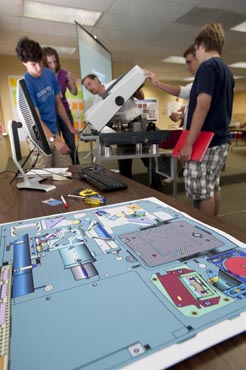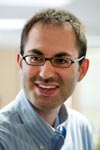Faculty aim to strengthen technology, science education by blending them
Josh Coon‘s labs are stocked with high-end scientific equipment, with tubing and computer boards and sample holders and even small refrigerators built onto boxes clicking and humming with motors and fans.

On July 29, 2009, a technician at Thermo Fisher Scientific in Fitchburg, Wis., dissassembles and shares with a group of regional high school students and their teachers the inner workings of one of the company’s spectrometers. The activity is part of a five-day technical education and science outreach program, known as TESci, led by the company’s scientists working in partnership with Josh Coon, anassistant professor of chemistry and biomolecular chemistry, and several UW–Madison graduate and postdoctoral students. The program is funded for five years by the National Science Foundation.
Photo: Bryce Richter
To the UW–Madison assistant professor of chemistry, it looks like the future of high school technical education — or, at least, a better understanding of technology’s place in science and vice versa.
“If you’re good at science, it’s good for you to be able to build stuff,” Coon says. “And if you’re more interested in the technical subjects, there’s a place for you in science.”
Coon, a group of UW–Madison researchers and Thermo Fisher Scientific scientists led by Simon Nunn will bring together high school students and teachers to build and use diagnostic equipment that would not be out of place in university research labs.
It’s an effort to make technical education programs more rigorous and relevant as well as give science-minded students a better foundation in technology. Coon struck on the idea after noticing that UW–Madison’s otherwise exemplary chemistry students were often reluctant or unable to design modifications for complex instruments to fit them to research tasks.
“They’re all really smart,” Coon says. “But when it comes to building and designing, that’s a pretty foreign concept. And in many fields of science it’s not unusual to get in with your hands and build the equipment you need. It’s not all theoretical and on paper.”
Thermo Fisher Scientific’s Madison facility will host a five-day camp — the TESci outreach program, a melding of technology education and science — starting Monday, July 27, for students and science teachers from Stoughton, DeForest Area, Evansville and Madison West high schools.

Coon
Paired off with Thermo Fisher Scientific engineers and UW–Madison scientists, the high school groups will progress from theory to practice with a generous helping of hands-on technology development in the middle. Each team will assemble a Thermo Scientific spectrometer.
“These are instruments used on shows like ‘CSI’ or in the pharmaceutical industry for quality control” and generally out of the reach of a high school lab, Coon says. “They don’t have these. Traditionally these instruments have been too expensive for the high school lab, and they require technical support. Technology advancements by Thermo Fisher have made the spectrometers more accessible to high school students.”
The students and teachers will use them to analyze plastics, completing a project in which they conceive a way to look for impurities in plastic toys, build the equipment necessary for the testing and then take the exercise a step further by stepping into their host’s shoes.
“The Thermo Fisher scientists and engineers will come in to give them a sense of the business end,” Coon says. “You’ve used the science to build a product, but then how do you market this? How do you sell it to people?”
Thermo Fisher Scientific will carry TESci into the fall by loaning each of the participating high schools a spectrometer to use in their classrooms.
“The teachers and the students who were in the summer program get to be the experts,” Coon says. “They’ll show their fellow teachers and students how to use the equipment and how it comes together.”
In addition to Thermo Fisher Scientific’s extensive support, TESci is funded for five years by the National Science Foundation.
“What I’d really like to see is a good blended participation,” Coon says. “Kids with the industrial tech interests blended with kids with the science interests, and hopefully they trade some of that interest and knowledge back and forth.”




